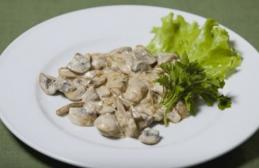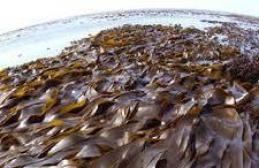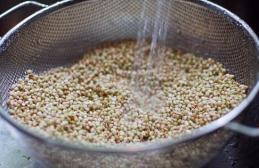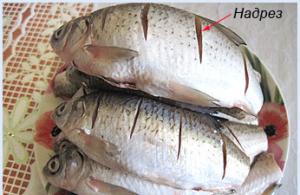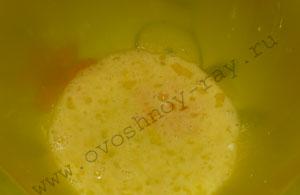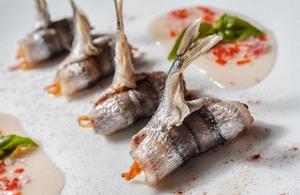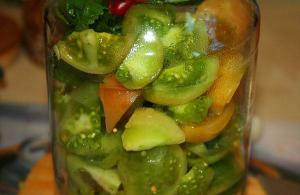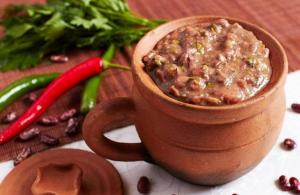It's no secret that Bechamel sauce is included in many French dishes, but is it truly French?
Like many French recipes, the origins of Bechamel sauce go back to Antiquity, when cooks thickened mixtures wheat flour and flavored them herbs and roots. ( Similar recipes have been preserved in the cuisines of many peoples of the world to this day.)
There are three main versions of the appearance of Bechamel sauce. According to the first of them, having become rich during the Fronde, the Marquis of Béchamel, thanks to his extensive knowledge of art, approached the Court of Louis XIV. He was very knowledgeable about painting and mahogany furniture and always gave competent advice to the king. However, his true passion was composing unique gastronomic mosaics, when large dishes Small colorful treats were served on the table.
Gradually, the marquis became the king's majordomo and became the Marquis de Nointel. Now he had to satisfy all the culinary needs of His Majesty. But it must be said that Louis the Fourteenth had an insatiable appetite, which at one time greatly shocked his sister-in-law and at the same time cousin Henrietta of England.
According to legend, it was in the castle of Nointel, using shallots and meat juice, that the Marquis invented his famous sauce.
"Becoming the chief manager royal table, the Marquis Bechamel did not limit himself only to orders: he loved to do things himself culinary business and sometimes made sauces. And then one day, seeing fish lying beautifully on a dish, he invented a sauce, very simple, but tasty.” (From the archives of A.F. Touch Cuisine.)
According to the second version, the gourmet Marquis Bechamel only improved an existing recipe, and supposedly its true inventor was Pierre de La Varenne (1615-1678), the cook of the Marquis Yuksel.
According to the third version, France is not the homeland at all famous sauce, but in fact, Catherine de Medici brought him there along with her cooks. This version is supported by the fact that in Italy, since ancient times, a sauce very similar in composition, called “Balzamella,” has been used.
One way or another, it seems that in certain circles, even in France, the sauce was known long before the Marquis Bechamel. For example, in the notes of the Duke de Cara we read: “What a lucky man this Bechamel is! 20 years ago I served stew from white meat birds with this sauce, and yet it was not named after me!”
Today, Bechamel is considered one of the most common sauces, and it still bears the name of the Marquise. True, instead meat juice modern cooks use milk or heavy cream and do not add it to soup, as was the case in the 18th century.
Once, a long time ago, I cooked it and got a paste that tasted disgusting. With lumps. After this bad experience, I forgot about the existence of bechamel for many years.
However, One of the five classics base sauces French cuisine. Also used as a component in many dishes European cuisine and as a base for various sauces. It’s not for nothing that it is one of the five basic sauces of classic French cuisine - it is used not only on its own, but also as a basis for a number of other sauces, such as component dishes such as soufflé.
I had to learn how to cook it so that now it is my favorite sauce.
Bechamel is a sauce quite simple in composition. There are only three required ingredients - butter, flour, milk. Mandatory spices just two - salt and pepper.
And the technology for cooking the sauce is also simple: flour is fried in oil (and a mixture called roux is obtained - RU), then the roux is boiled with milk, salt and pepper are added - that's all.
Why do beginners end up with a paste instead of a creamy sauce or lumps that cause the sauce to not have a smooth, silky texture?
The secret, as always, is technology.
1. So that bechamel has creamy taste, it is boiled either for no more than 5-7 minutes, or for at least 40-60 minutes.
Moreover, long cooking is classic approach, short - modern.
Why exactly this way and not otherwise?
It has been proven in practice that if you cook flour for more than 10 minutes and less than forty hours, the sauce will have the taste of “raw” flour, that same nasty pasty taste.
During short cooking, this taste does not have time to develop, and during long cooking it disappears.
2. To avoid lumps and ensure a smooth texture, the milk and roux should be at diametrically opposed temperatures.
If the roux is cold (made in advance and stored in the refrigerator), then the milk should be hot.
If the milk is hot (cooked with spices), then the roux should be cooled before mixing
.If the roux is hot and the milk is boiling, the flour is instantly brewed and the appearance of lumps is unlikely to be avoided, in any case, it will be difficult.
If the milk is cold and the roux is cold, then the flour coated with butter will not mix with the milk, but will float in lumps. This sauce will need to be stirred intensively all the time while it is heating up, otherwise some of the lumps of flour will have time to brew without dissolving.
A good option is warm roux and warm milk. The inconvenience is that you need to heat one and cool the other before mixing, which is not always convenient.
Recipe.
To prepare roux, use an equal amount butter and flour.
For liquid bechamel sauce, take a ratio of 120-180 grams of roux per liter of milk, for thick bechamel sauce used in soufflés - 300 grams of roux per liter of milk.
However, the simplest and most memorable recipe is: 10 grams of butter - 10 grams of flour - 100 ml of milk.
Except classic sauce, there is a completely full-fledged, more spiced version.
Classic bechamel (for 500 ml milk)
It is best cooked in a single-handle, thick-bottomed, non-stick pan.
You cannot use uncoated aluminum pans - the cream in them will turn grey.
The sauce starts with making the roux.
1. Place 50 grams of butter in a frying pan and melt it over very low heat. Under no circumstances should the oil start to fry! If it is very cold, you need to cut it into small cubes, otherwise some of the butter will start to burn before all the butter melts.
Remember - you are making white sauce, the oil should not change color!
2. Pour 50 grams of flour into the butter and thoroughly rub the mixture with a spatula. Stirring and rubbing, keep the flour on the fire until it “boils” and rises like a “cap” and foam appears around.
Like this.

Lumps of flour - if there are any - should not bother you at this stage.
3. Measure out 500 ml of milk. Remove the saucepan from the heat and gradually in small portions, slowly add milk, whisking and stirring the sauce all the time. Use 100 - 150 ml of milk for this.
4. When the sauce becomes homogeneous, add the remaining milk, return the saucepan to the heat, stirring continuously, bring the sauce to a boil over medium heat and simmer for 5-7 minutes ( maximum) from the moment of boiling.
5. Season the sauce to taste with salt and freshly ground white pepper. Transfer the sauce to a dry container.
6. Piece cling film Grease with butter and press the film tightly onto the surface of the sauce.
7. If you want to keep the sauce warm, place it in a water bath.
If you want to cool it, place the sauce container in a container with ice water.
Cold sauce can be stored in the refrigerator for 2-3 days without compromising quality or taste.
Bechamel with spices (for 500 ml milk)
1. Prepare the roux (see above, proportions unchanged), then transfer it to a clean bowl and leave to cool completely.
2. Prepare a set of spices:
onion (ideally The bulb is small, weighing 25-50 g, color from purple to white. Both bulbs and leaves (feathers) are eaten raw, fried, sautéed, boiled, and pickled. Onion spicy varieties often used in decoctions, stews, soups, minced meat, and also added to meat, fish, vegetable dishes. Sweet onions are consumed fresh or pickled as a snack or side dish, in salads.)
2 cloves
1 Bay leaf IR
a piece Nutmeg is widely used in almost any culinary dishes: in salads, homemade and industrial sausages, first courses, meat, seafood, desserts, baked goods, teas, coffee. Grated nutmeg gives dishes a subtle spicy, sweetish aroma and taste.
a few white peppercorns
Crush everything coarsely and place in a spice trap (optional).

3. Pour 550 ml of milk into a saucepan, add spices and cook the milk for 15 minutes.
4. Strain the milk through a fine sieve, return to a clean saucepan (if the milk has boiled down too much, add fresh milk up to 500 ml), heat the milk almost to a boil (there is already a slight steam, but there are no bubbles yet), remove it from the heat.
5.Add COLD roux to the milk. And all at once! Whisk the milk until the roux is dispersed and the sauce is smooth.
6. Next - everything is the same as described above.
Bugs and corrections.
If the sauce turns out lumpy, rub it through a fine sieve or beat in a blender.
If the sauce is too thick, add milk, stir the sauce and heat again.
If the sauce turns out too liquid, then there are two ways to correct the situation: boil the sauce or add it to the sauce a small amount of butter, ground with flour (flour: butter 1:1), and then boil the sauce for a couple of minutes after boiling.
What sauce should I make?
If bechamel is used as a component of another dish or as a binding additive - and unless otherwise specified in the recipe -
then classic bechamel is used.
If you love spices and use bechamel as a sauce that gives a neutral-tasting dish an additional flavor, cook bechamel with spices.
Having lived half your life, you sometimes learn incredible stories about such simple and familiar things as the history of ordinary gravy. Everyone always made the usual gravy with fried flour, cream and broth. Now communicating with professional chef, I find out that this gravy is none other than Bechamel sauce. And the history of its creation goes back to the reign of French king Louis 14th. Bechamel sauce, it turns out, is one of the five basic sauces of French cuisine, and on its basis the entire variety of sauces that are currently used is already prepared. I often hear it called bechamel, but I only recently heard the story of its creation. What is this mysterious bechamel sauce? It turns out that the chef decided to simply add a little cream to the thick white sauce. This cook's name was Bechamel. This is how the name of the sauce came about. When you first hear the name of this sauce, you think that it is something terribly complicated. It will be very difficult to prepare the sauce. But after reading the recipe for bechamel sauce, my opinion changes.
What is the secret of cooking? The basis of bechamel sauce is milk or cream, the second integral component is flour, fried in butter to a certain color. The third component is broth, for sauce intended for meat - meat, for fish - fish. This is how bechamel sauce is made! The mystery has been solved! You can cook, but before that you need to learn the little subtleties of preparing bechamel. Even after studying the intricacies of cooking, it may not work out right away the way it is prepared. experienced chefs. You can try, you have to start from the very beginning simple recipe preparing bechamel sauce.
How to prepare bechamel sauce without spoiling it?
The flour is fried in oil in the proportion of 100g of oil - 1 spoon of flour, until light brown; if you overfry, the taste of the sauce will deteriorate;
For the sauce you can use milk or cream, you cannot use sour cream; it will curdle when heated, this is at the discretion of the housewife, but you need to add cream in a thin stream so that no lumps form;
— when preparing the sauce, use wooden spoons or spatulas;
Sauté the onions and vegetables in a frying pan a little before adding them to the sauce;
It is better to put spices and seasonings in warm milk To get the flavor, the spices should not interrupt the taste of the sauce;
If the sauce is intended for cooking, for example, the dish “fish with bechamel sauce”, make it liquid consistency;
— the sauce is cooked over low heat, with continuous stirring, it contains flour, so it can easily burn;
Cannot be included in sauce lemon juice it will curdle cream or milk;
The sauce can be stored in the refrigerator for 3-4 days, but it is recommended to serve bechamel only hot. To prevent the sauce from becoming covered with a thick film in the refrigerator, pour a little melted butter onto its surface.
 The main thing is what you can do with the sauce various additives, at the discretion of the cook or housewife, add new shades of taste. You can experiment with spices, perhaps add bay leaf, nutmeg and onion. Dip spices in grains or powder into milk in linen bags, but it is better to use ones that are easily removed from the finished sauce. The recipe for bechamel sauce is not constant, but the main thing is to preserve its main components, which make this sauce unique and exquisite. The degree of thickness of the sauce also depends on the purpose of its use; it can be made according to the recipe, or you can add a little more broth and it will become more liquid. Bechamel sauce has wide application. It goes well with veal, pork, potatoes and vegetable dishes. It can be used when preparing julienne, it will cover the dish golden crust. It's good to use béchamel sauce for lasagna, but remember that the sauce is not a dressing and is not recommended. An ideally prepared béchamel sauce should have a soft creamy color, a uniform structure and consistency of sour cream, and should flow easily from a spoon. The sauce serves not only as a decoration for the dish. The main thing is to have pleasant taste and complement the taste of the dish with which it is served. The purpose of all sauces is to stimulate appetite and promote better absorption. Let's try to cook. We got acquainted with bechamel - here is a simple recipe:
The main thing is what you can do with the sauce various additives, at the discretion of the cook or housewife, add new shades of taste. You can experiment with spices, perhaps add bay leaf, nutmeg and onion. Dip spices in grains or powder into milk in linen bags, but it is better to use ones that are easily removed from the finished sauce. The recipe for bechamel sauce is not constant, but the main thing is to preserve its main components, which make this sauce unique and exquisite. The degree of thickness of the sauce also depends on the purpose of its use; it can be made according to the recipe, or you can add a little more broth and it will become more liquid. Bechamel sauce has wide application. It goes well with veal, pork, potatoes and vegetable dishes. It can be used when preparing julienne, it will cover the dish golden crust. It's good to use béchamel sauce for lasagna, but remember that the sauce is not a dressing and is not recommended. An ideally prepared béchamel sauce should have a soft creamy color, a uniform structure and consistency of sour cream, and should flow easily from a spoon. The sauce serves not only as a decoration for the dish. The main thing is to have pleasant taste and complement the taste of the dish with which it is served. The purpose of all sauces is to stimulate appetite and promote better absorption. Let's try to cook. We got acquainted with bechamel - here is a simple recipe:
Bechamel sauce. Butter 2 tbsp. Grind spoons with 2 tbsp. spoons of flour, heat in a frying pan, stirring constantly until light brown. Add a cinnamon stick and salt to the heated cream and pour a thin stream of cream into the pan, stir thoroughly, avoiding the formation of lumps. Ready sauce transfer to a gravy boat. Use for cooking according to recipe.
Salmon with bechamel sauce. You will need 600g salmon, 1 root each of carrot, parsley and celery, 1 onion, 5-6 peppercorns, salt, herbs. Take a piece of fish, scald it with boiling water, remove the skin, add water, add washed and chopped roots, spices and onions. Cook over low heat until half cooked. Remove the fish, cool, and cut into even pieces. Place in a baking dish. Pour over the sauce. Bake for 30-40 minutes. Serve with greens.
Baked pork with bechamel sauce. 1 kg required pork ham, 1 carrot, parsley and horseradish root, 2 onions, one star anise, green salt. Place the pork in a saucepan, add water, and cook until tender with spices. Cool, cut into thin slices, and place in a baking dish. Pour over cold sauce. Bake for 20-30 minutes. Serve hot with shallots cut into thin rings and herbs.
Poultry julienne. You will need 300 g of chicken fillet, 300 g of champignons, cut the champignons into slices. Chicken fillet cut across the grain into strips and lightly fry in oil, add mushrooms to it and simmer for a short time. Heat the oven. Place chicken fillet with mushrooms in cocotte bowls, sprinkle with grated cheese and pour over bechamel sauce. Bake for 20-30 minutes. Serve hot.
Bechamel is one of the five main French sauces once again confirms to us the truth “everything ingenious is simple.”
The first mention of this sauce appeared in Le Cuisinier François, a book published in 1651 and written by the cook of Louis the 14th Francois Pierre de La Farenne (1615 - 1678). This book was reprinted 30 times over the next 75 years and is considered to have defined and founded French cuisine. The sauce got its name in order to flatter the court nobleman Marquis Louis de Béchamel, Marquis of Nuatel (1603–1703), who was once the head of the French province of Brittany. The Marquis is often and unfairly cited as the inventor of this sauce, while the name a simple cook, to whom we really owe the appearance of Béchamel, remains unknown.
They say that this sauce was born by accident. The chef just decided to add a little cream to the usual thick white sauce V eloute (“veloute” or “Parisienne”). Since then, for several centuries, Bechamel sauce has been popular all over the world. It is easy to prepare and versatile to use, as it goes equally well with hot meat, fish and vegetable dishes. In addition, it is easy to change and expand. You can make various additions to this sauce, each time getting a new flavor. For example, in Holland and Belgium they like to add ground nutmeg to Bechamel, and in France they like to add bay leaf and very finely chopped onions. Bechamel sauce can be seasoned low calorie salads, or use it as a dressing in the preparation of many soups and puree soups. Bechamel is an essential component of Bolognese lasagna. And thanks to the fact that when baked, the sauce is covered with a beautiful golden brown crust, it is with it that such a dish as julienne is prepared.
##There isn't just one the right recipe preparing Bechamel sauce. But there are essential components and technological rules.
First of all, it is an oil-flour base. It is this that “binds” the sauce, giving it the necessary thickness. This base is called “Roux” (“Les roux”), and according to the degree of frying of the flour, it is divided into brown “Roux brun” and light brown “Roux” ( "Roux blond") “Ru” is characterized by a predominance of butter over flour. For 100 grams of butter - 1 tablespoon (with top) of wheat flour.
The second component is the broth. The amount of broth depends on what base you use to prepare the Bechamel. If this thick sour cream, or thick country cream - then you can use more broth. If it's ordinary liquid cream or milk, then the broth should be as concentrated as possible, and added literally in the amount of several spoons.
It’s up to you to decide what exactly to use as the third, dairy component, cream, milk or sour cream. They are equally suitable for making Bechamel.
Here are three simple recipes for making sauce with precise proportions.
Bechamel with cream (classic)
You will need:
100 grams of butter
1 tablespoon flour
3-4 tablespoons concentrated broth
250 grams cream 20%
Salt – 1/3 teaspoon
Spices to taste (pepper, nutmeg)
Melt the butter in a saucepan or high-sided frying pan over low heat.
Add flour and stir with a spatula until no lumps remain. The flour should only be slightly “dissolved” in the oil, but under no circumstances should it be overcooked.
As soon as the flour disperses in the oil, becomes covered with foam, but has not yet changed color to light brown, pour cold broth into the saucepan and stir.
Continuing to stir, pour in the cold cream in a thin stream.
Add salt and spices. Bring to a boil. Almost immediately the sauce will thicken to the desired consistency. Stir the finished Bechamel well again until smooth.
If you are not going to use the sauce immediately, pour it into any suitable container with a tight lid. Melt separately small piece butter and carefully pour a thin layer onto the surface of the sauce. A layer of butter will keep the sauce from drying out and will keep it for several days.
Bechamel with milk (light)
A simplified sauce recipe, without broth.
You will need:
100 grams of butter
1 tablespoon flour (topped)
250 ml milk
1/3 teaspoon salt
Spices (eg white ground pepper) on the tip of a knife
Melt the butter in a frying pan or saucepan over low heat, add flour and stir well.
Heat the flour in the oil (about half a minute). Then, continuing to stir constantly, pour in cold milk in a thin stream. Salt and pepper. Bring the sauce to a boil and simmer, still stirring, for about another minute. Until the sauce thickens.
Remove the finished sauce from the stove. If you are not going to use it right away, pour it into suitable dishes with a lid, pour a thin layer of butter as described in previous recipe and store in the refrigerator.
Bechamel with sour cream (catering version)
You will need:
100 grams of butter
1 heaped tablespoon of flour
1 cup (250 ml) any meat broth

.JPG)
.JPG)
.JPG)
.JPG)
.JPG)
.JPG)
.JPG)
.JPG)
